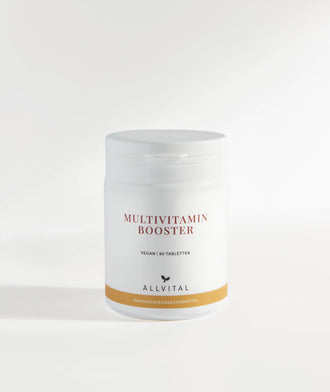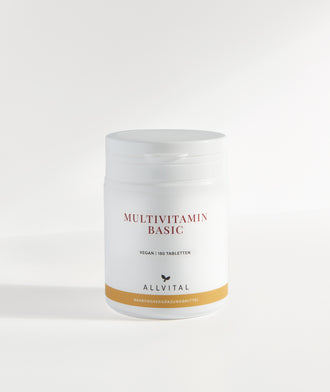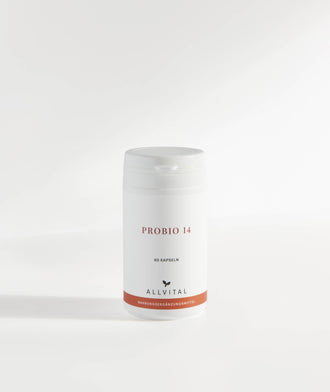
Stable blood sugar levels thanks to a healthy diet
Chronically elevated blood sugar levels affect many people and can have far-reaching negative consequences for our health. With a suitable diet, we can maintain healthy blood sugar regulation and actively counteract existing disease processes.
Our diet has a significant influence on our health. An unhealthy, sugar- and carbohydrate-heavy diet is one of the main risk factors for a disruption of blood sugar regulation and thus also for the development of type II diabetes. A healthy diet rich in vital nutrients, on the other hand, can act as a remedy and help to reverse chronic disease processes.
In this article, we would first like to give you an overview of the process of blood sugar regulation and the development of diabetes and then show you measures you can take to keep your blood sugar stable by natural means. The focus here is on nutrition. Finally, we will also introduce you to some of our nutritional supplements that can provide additional support for blood sugar regulation.
Why stable blood sugar is important?
The blood sugar level is the level of glucose (dextrose) in the blood. For optimal function and health of the body, this level must be neither too high nor too low.
If the blood sugar level drops too low, this has a particularly negative effect on the brain and the central nervous system, as nerve cells are not able to produce glucose themselves. A lack of clear thinking, tiredness and weakness can therefore be signs of a drop in blood sugar levels.
Severe hypoglycaemia can even lead to symptoms such as confusion, seizures and even coma. A dangerous drop in blood sugar can occur, for example, in diabetic patients with an overdose of insulin.
However, a far more common problem is a chronically elevated blood sugar level. High blood sugar levels promote inflammatory processes in the body. Among other things, this leads to damage to the blood vessel walls, which favours the development of arteriosclerosis (hardening of the arteries). Arteriosclerosis is an important risk factor for the occurrence of cardiovascular diseases such as heart attacks and strokes. It also favours the occurrence of kidney diseases, eye diseases (cataracts) and nerve damage.
In the following sections, we explain how chronically high blood sugar levels can occur.
How is blood sugar regulated?
The body regulates blood sugar levels mainly through the interaction of the two hormones insulin and glucagon:
- Insulin is produced in the beta cells of the pancreas and promotes the uptake of glucose into the cells. Insulin is released when the blood sugar level rises after food intake and causes the level to fall again.
- Glucagon is the antagonist of insulin and is produced in the alpha cells of the pancreas. The hormone is released when the blood sugar level drops. It promotes the release of glucose from the glycogen stores in the liver and muscles and also stimulates the formation of new glucose (gluconeogenesis), which mainly takes place in the liver and kidneys.
Disruption of blood sugar regulation
At the centre of the development of the widespread disease type II diabetes, also known as diabetes mellitus or adult-onset diabetes, is the development of so-called insulin resistance. Insulin-resistant cells no longer react as sensitively to insulin as healthy cells and are therefore less able to absorb glucose from the blood.
The most important cause of the development of insulin resistance is years of malnutrition with high levels of isolated carbohydrates (e.g. white flour products) and sugar.
Sugar leads to glucose peaks
After food intake, the breakdown of carbohydrates in the intestine and the absorption of glucose via the intestinal wall lead to a rise in blood glucose levels. If the food is rich in sugar and white flour products, this rise is particularly rapid and sharp.
The sharp rise in the blood sugar level is a signal for the pancreas to release a particularly large amount of insulin so that the sugar can be transported quickly from the blood into the cells. This initially leads to a rapid rise in blood glucose and shortly afterwards to an equally rapid drop. This is known as a glucose spike.
Hyperglycaemia and hypoglycaemia
This type of diet therefore does not lead to stable blood sugar levels and sustained satiety, but to a constant rise and fall in glucose levels.
Immediately after a meal, the blood sugar level shoots up sharply and you briefly enter a state of hyperglycaemia. However, due to the strong release of insulin, the glucose level drops again immediately afterwards and you may even experience hypoglycaemia, even though you have consumed a lot of calories. This can lead to mood swings, tiredness, concentration problems and food cravings.
After a glucose spike, the temptation is therefore great to reach for the chocolate bar again instead of the plate of salad.
Vicious circle: insulin resistance
If the body is exposed to such a diet for years, insulin resistance gradually develops.
Due to the chronically high insulin levels, the insulin receptors in the cells eventually no longer react as sensitively to insulin as they would in a healthy person. This particularly affects the cells of the muscles, fatty tissue and liver. As a result, less glucose reaches the inside of the cells and the blood sugar level remains elevated for longer after a meal.
The consequences:
- The pancreas tries to secrete even more insulin until it is finally exhausted and the patient needs insulin.
- Insulin resistance continues to increase.
- The blood sugar level remains chronically elevated and no longer falls back into the normal range.
Type I and type II diabetes
The previous section explains important correlations in the development of type II diabetes, a common disease of civilisation. Type II diabetes used to be considered a "typical old-age disease", hence the term "adult-onset diabetes". Nowadays, however, more and more children, adolescents and young adults are also affected by this disease.
In addition to an unfavourable diet, there are other risk factors for the development of type II diabetes:
- Lack of exercise
- Obesity
- Chronic stress
- Lack of sleep
- Impaired intestinal flora
- Lack of micronutrients
Type I diabetes must be distinguished from type II diabetes. Type I diabetes is an autoimmune disease in which the insulin-producing beta cells of the pancreas are destroyed. The disease usually begins in childhood and those affected have to inject insulin throughout their lives to control their glucose levels.
Acquired type II diabetes, on the other hand, can be cured in many cases through a change in lifestyle.
Diabetes is common
According to the Robert Koch Institute (RKI), almost 10 % of adults in Germany suffer from diabetes ( 1 ). Over 90 % of these cases are type II diabetes.
A further 20 % of adults have an increased risk of developing type II diabetes ( 2 ). This is known as prediabetes, i.e. a preliminary stage of diabetes. The people affected are already characterised by elevated blood sugar levels. However, these are still below the levels of patients with type II diabetes.
In Germany, around 30% of people are affected by diabetes or prediabetes.
What are normal blood glucose levels?
Blood glucose is expressed in milligrams per decilitre (mg/dl) and is usually measured on an empty stomach. In the case of suspicious values, the blood glucose level is also measured at a certain distance from food intake in order to better assess the extent to which blood glucose regulation is impaired.
The following categorisation applies to adults (3):
1) Fasting
- Normal: < 100 mg/dl
- Prediabetes: 100 - 126 mg/dl
- Type II diabetes: > 126 mg/dl
2) 2 hours after food intake
- Normal: < 140 mg/dl
- Prediabetes: 140 - 200 mg/dl
- Type II diabetes: > 200 mg/dl
In addition to the glucose value, the so-called HbA1c value is also important for the assessment of blood glucose regulation. This value describes the proportion of glycosylated haemoglobin ("sugared" red blood pigment) in relation to total haemoglobin. The HbA1c value provides information about the average blood glucose concentration over the past 8 to 10 weeks.
Which foods cause glucose spikes?
Quickly digestible carbohydrates such as refined sugar and white flour products trigger particularly strong glucose peaks. The body has little digestive work to do here and the blood sugar level rises quickly and sharply.
To prevent diabetes, sugar should therefore be avoided first and foremost. This includes cane sugar, beet sugar, fructose and all syrupy sweeteners such as maple syrup, agave syrup or rice syrup. High sugar contents can be found in sweets, in many processed foods and ready meals, in baked goods and in soft drinks and other sweetened beverages.
White flour products include many baked goods and types of pasta. In addition, white rice or starchy foods such as various potato products can also lead to a sharp rise in blood sugar.
If you are diabetic or at increased risk of diabetes, it is best to remove such foods from your diet altogether and opt for healthier alternatives instead.
Foods for a stable blood sugar level
An ideal blood sugar curve should rise moderately after a meal and then slowly fall again - without high spikes. This keeps the blood sugar level stable so that you feel fit and focussed over a long period of time and do not experience cravings.
You can keep your blood sugar stable and avoid glucose peaks by choosing and combining foods carefully.
Dietary fibre
Dietary fibres are certain indigestible components of plant-based foods. A distinction is made between water-soluble dietary fibres such as inulin and pectin and water-insoluble dietary fibres such as cellulose and lignin.
Dietary fibres have numerous health-promoting effects. For example, they stimulate saliva production and intestinal activity and promote a feeling of fullness.
A favourable effect on glucose metabolism has also been found for soluble dietary fibres in particular. Fibre slows down the absorption of glucose from the intestine, causing blood glucose levels to rise slowly over a longer period of time (4).
High fibre content is found in many types of vegetables (e.g. green leafy vegetables), in various types of fruit (e.g. apples, pears, many types of berries), in pulses and whole grains.
Complex carbohydrates
Carbohydrates are the only nutrients that directly influence blood sugar levels. Depending on the type of carbohydrate, there is a faster or slower rise in blood sugar.
The glycaemic index (GI) is often used to indicate the blood sugar-increasing effect of carbohydrates. A high GI means that the carbohydrates are rapidly absorbed into the blood. With a low GI, the blood sugar rises slowly.
For the prevention and treatment of diabetes, foods with a low GI that contain complex carbohydrates instead of white flour and sugar should be favoured. These include wholemeal cereals, quinoa and pulses, for example.
However, the total amount of carbohydrates should not be too high. Small portions of complex carbohydrates in combination with fibre-rich vegetables are ideal.
High-quality proteins
High-quality proteins are important components of a healthy diet, as they are needed for many tasks in the body. They should therefore be included in the diet in moderation.
Good sources of high-quality proteins are, for example, unprocessed meat from naturally reared animals or various plant-based foods such as pulses and nuts.
In healthy people or in patients with type II diabetes who still have enough insulin, proteins only have a minor effect on blood sugar levels. However, if there is an insulin deficiency, even a meal rich in protein can lead to a sharp rise in blood sugar, as the body starts gluconeogenesis immediately after ingesting the protein building blocks (5).
This mainly affects patients with type I diabetes. The rise in blood sugar is delayed compared to the rise after a carbohydrate-rich meal, as proteins are digested more slowly. Diabetics who are dependent on insulin may therefore need another dose of insulin after a protein-rich meal.
Healthy fats
Dietary fats have no direct effect on blood sugar levels. However, a very high-fat diet favours the development of insulin resistance ( 6 ).
Healthy fats are important for health and should be included in a balanced diet. Good sources of fat include cold-pressed olive oil or linseed oil, coconut oil and nuts. Omega-3-rich oils such as high-quality algae oil are also favourable. Omega-3 fatty acids counteract chronic inflammatory processes.
Refined oils that are produced using heat and chemicals, on the other hand, should be avoided at all costs. They sometimes contain high levels of so-called trans fatty acids, which, among other things, increase the risk of arteriosclerosis by increasing the level of LDL cholesterol ("bad" cholesterol) in the blood. This is particularly harmful for diabetes patients, who are at risk of arteriosclerosis due to permanently elevated blood sugar levels.
Pre- and probiotics
The health of our gut has an important influence on blood sugar regulation and the health of our metabolism. Prebiotics and probiotics can support the gut.
Prebiotics are substances that serve as food for the beneficial intestinal bacteria. These include numerous soluble fibres such as pectin and inulin. Pectin is found in apples, quinces and citrus fruits, for example, while inulin is abundant in Jerusalem artichokes, black salsify and garlic, for example. The gel that forms from psyllium husks, linseed or chia seeds on contact with water also has a prebiotic effect.
Probiotics are preparations of living microorganisms (e.g. lactic acid bacteria). For probiotics to be effective, the environment in the intestine must be suitable for the microorganisms to colonise. The environment refers to the pH value in the intestine on the one hand and the presence of substances to feed the desired bacteria on the other. The intake of prebiotics and a healthy, high-fibre diet are the most important measures to create these conditions.
As an alternative to taking probiotics as a dietary supplement, fermented foods such as sauerkraut, miso and kimchi are also suitable for this purpose. These foods contain probiotic bacterial strains.
Drink enough water
Drinking sufficient amounts of water (e.g. 1.5 to 2 litres) regulates the body's water balance, helps to eliminate harmful metabolic products and regulates the appetite. People who drink plenty of water have fewer food cravings.
Special ingredients
Numerous studies also show that certain foods have a favourable effect on blood sugar levels. The effect is usually due to one or more special ingredients in these foods.
Some examples are
- Cinnamon: Daily intake of cinnamon can have a favourable effect on blood sugar and blood lipid levels in patients with type II diabetes ( 7 ). Cinnamon also stimulates the production of the body's own antioxidants.
- Blueberries: Blueberries can improve insulin sensitivity ( 8 ). The effect is said to be due to various antioxidant plant substances (e.g. anthocyanins).
- Ginger: Daily intake of ginger can improve the blood sugar levels of diabetes patients ( 9 ). The main active ingredient in ginger is gingerol.
- Almonds: Daily consumption of almonds can also counteract insulin resistance and is particularly suitable for people with prediabetes ( 10 ).
Lifestyle changes
In addition to a change in diet, sufficient physical activity, stress management and good sleep hygiene are other factors that contribute to healthy blood sugar regulation.
Physical exercise
Regular physical activity increases the insulin sensitivity of muscle cells and thus counteracts insulin resistance and the development of diabetes. Both endurance and strength training have proven to be effective in studies. Even a daily walk can have a positive effect.
Stress management
Stress can affect blood sugar levels by increasing the release of hormones such as cortisol and adrenaline, which in turn cause blood sugar to rise. Techniques such as meditation, breathing exercises and yoga can help to reduce stress and thus stabilise blood sugar levels.
Sleep
Sufficient and high-quality sleep also plays an important role in regulating blood sugar levels. A lack of sleep can impair insulin sensitivity and lead to poorer blood sugar control.
Insulin resistance due to disturbed intestinal flora
The proliferation of certain pathogenic bacteria in the gut in combination with an increasingly permeable gut barrier (leaky gut syndrome) can be an important factor in the development of metabolic diseases such as type II diabetes ( 11 ).
When these bacteria die off, toxins are released (lipopolysaccharide), which enter the bloodstream via the permeable gut and trigger chronic inflammatory processes in the body. Among other things, this favours the development of insulin resistance.
Improving intestinal health is therefore also an important aspect in the prevention and treatment of diabetes.
Food supplements for healthy blood sugar levels
Various dietary supplements can help to control blood sugar levels.
For the gut
Our product ProBio 14 contains a combination of 14 natural bacterial cultures, including lactobacilli and bifidobacteria. ProBio 14 also contains various prebiotics such as inulin and fructooligosaccharides.
Antioxidants and secondary plant substances
Phyto Balance is a plant-based active complex that contains curcuma and maca root, among other things. Maca, or Peruvian ginseng, has a very rich amino acid spectrum and contains many valuable unsaturated fatty acids. Numerous studies on humans show that ginseng can effectively reduce fasting blood sugar ( 12 ).
The effects of curcumin, the main active ingredient in curcuma, have also been well researched. Curcumin has an antioxidant effect and strengthens the immune system. It has also been shown to be effective against diabetes in animal studies ( 13 ).
Other ingredients in Phyto Balance include angelica root, lavender, Japanese knotweed and inulin. Phyto Balance is therefore a herbal power mix that optimally combines numerous natural active ingredients.
Micronutrients
The need for micronutrients is generally increased in chronic diseases, including diabetes. At the same time, various vital substances (especially water-soluble vitamins) are excreted in the urine in significantly larger quantities in diabetes than in healthy people.
Our Multivitamin Basic and Multivitamin Booster preparations, which combine 47 different vital substances, are an ideal daily supplement to provide the body with all the important micronutrients it needs. Multivitamin Booster contains twice the dose of Multivitamin Basic and is therefore particularly suitable for people with increased requirements.
Sources:
- Prevalence of known and unknown diabetes. Diabetes Surveillance, Robert Koch Institute [Internet]. [accessed on: 02.01.2024].
- Prediabetes. Diabetes Surveillance, Robert Koch Institute [Internet]. [accessed on: 02.01.2024].
- Weber E. Blood glucose values, Which values are normal? Praktischarzt [Internet]. Updated on: 06.11.2023 [accessed on: 02.01.2024].
- Chen C, Zeng Y, Xu J, et al. Therapeutic effects of soluble dietary fibre consumption on type 2 diabetes mellitus. Exp Ther Med. 2016;12(2):1232-1242. doi:10.3892/etm.2016.3377
- Franz MJ. Protein: metabolism and effect on blood glucose levels. Diabetes Educ. 1997;23(6):643-651.
- von Frankenberg AD, Marina A, Song X, Callahan HS, Kratz M, Utzschneider KM. A high-fat, high-saturated fat diet decreases insulin sensitivity without changing intra-abdominal fat in weight-stable overweight and obese adults. Eur J Nutr. 2017;56(1):431-443.
- Khan A, Safdar M, Ali Khan MM, Khattak KN, Anderson RA. Cinnamon improves glucose and lipids of people with type 2 diabetes. Diabetes Care. 2003;26(12):3215-3218.
- Stull, AJ et al, Bioactives in Blueberries Improve Insulin Sensitivity in Obese, Insulin-Resistant Men and Women, August 2010, J Nutr.
- Khandouzi N, Shidfar F, Rajab A, Rahideh T, Hosseini P, Mir Taheri M. The effects of ginger on fasting blood sugar, hemoglobin a1c, apolipoprotein B, apolipoprotein a-I and malondialdehyde in type 2 diabetic patients. Iran J Pharm Res. 2015;14(1):131-140.
- Wien M et al, Almond consumption and cardiovascular risk factors in adults with prediabetes, Journal of the American College of Nutrition, 2010 Jun;29(3):189-97.
- Lau WL, Tran T, Rhee CM, Kalantar-Zadeh K, Vaziri ND. Diabetes and the Gut Microbiome. Semin Nephrol. 2021;41(2):104-113.
- Shishtar E et al. The Effect of Ginseng (The GenusPanax) on Glycemic Control: A Systematic Review and Meta-Analysis of Randomised Controlled Clinical Trials. PLoS One, 2014.
- Pivari F, Mingione A, Brasacchio C, Soldati L. Curcumin and Type 2 Diabetes Mellitus: Prevention and Treatment. Nutrients. 2019;11(8):1837. Published 2019 Aug 8.





